Skien
Skien kommune | |
|---|---|
   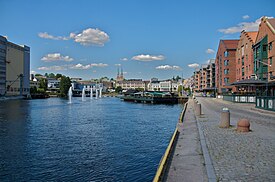 | |
 Coat of arms 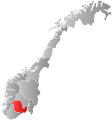 Vestfold og Telemark within Norway | |
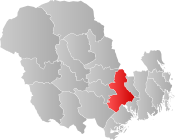 Skien within Vestfold og Telemark | |
| Coordinates: 59°12′29″N 9°33′10″E / 59.20806°N 9.55278°ECoordinates: 59°12′29″N 9°33′10″E / 59.20806°N 9.55278°E | |
| Country | Norway |
| County | Vestfold og Telemark |
| District | Grenland |
| Administrative centre | Skien |
| Government | |
| • Mayor (2013) | (AP) |
| Area | |
| • Total | 779 km2 (301 sq mi) |
| • Land | 719 km2 (278 sq mi) |
| Area rank | 140 in Norway |
| Population (30 September 2019) | |
| • Total | 54 887 |
| • Rank | 7 in Norway |
| • Density | 83.1/km2 (215/sq mi) |
| • Change (10 years) | 14.6% |
| Time zone | UTC+01:00 (CET) |
| • Summer (DST) | UTC+02:00 (CEST) |
| ISO 3166 code | NO-3807 |
| Official language form | Neutral[1] |
| Website | www |
Skien (Norwegian: [ˈʂêːən] (![]() listen))[2] is a city and municipality in Vestfold og Telemark county in Norway. In modern times it is regarded as part of the traditional region of Grenland, although historically it belonged to Grenmar/Skiensfjorden, while Grenland referred the Norsjø area and Bø. The administrative centre of the municipality is the city of Skien. Skien is also the capital of Vestfold og Telemark county.
listen))[2] is a city and municipality in Vestfold og Telemark county in Norway. In modern times it is regarded as part of the traditional region of Grenland, although historically it belonged to Grenmar/Skiensfjorden, while Grenland referred the Norsjø area and Bø. The administrative centre of the municipality is the city of Skien. Skien is also the capital of Vestfold og Telemark county.
Skien is one of Norway's oldest cities, with an urban history dating back to the Middle Ages, and received privileges as a market town in 1358. From the 15th century, the city was governed by a 12-member council. The modern municipality of Skien was established on 1 January 1838 (see formannskapsdistrikt). The rural municipalities of Gjerpen and Solum were merged into the municipality of Skien on 1 January 1964.
The conurbation of Porsgrunn/Skien is reckoned by Statistics Norway to be the seventh largest urban area in Norway, straddling an area of three municipalities: Skien municipality (about 62% of the population), Porsgrunn (30%), and Bamble (8%). This area is home to more than 100,000 people.
Skien was historically a centre of seafaring, timber exports and early industrialization, and was one of Norway's two or three largest cities between the 16th and 19th centuries. It was also one of Norway's most internationally oriented cities, with extensive contact with its export markets in the Low Countries, the United Kingdom and Denmark. It retained its position as Eastern Norway's leading commercial city until the 19th century, when it gradually started to lose importance to the emerging capital of Christiania following the Napoleonic Wars.[3] The city was the birthplace of playwright Henrik Ibsen, and many of his famous dramas are set in places reminiscent of early 19th-century Skien.
General information[]
Name[]
The Old Norse form of the name was Skiða (from the word skiða which means "straight plank", and which is also the origin of the word ski), and the town is probably named after a brook (with a straight run) with this name.
Coat-of-arms[]
The coat-of-arms is derived from the oldest known seal of the city, dating back to 1609. The seal shows two skis and in the middle a cross, with a small star on the crosspoint. The skis are a semi-canting element (based on a misunderstanding of the meaning of the town's name) and the cross is a religious symbol. There have been several theories about the meaning of the cross, but its meaning is not clearly known. It has been suggested that it is a symbol for the main church in Skien, the Holy Cross church. The small star may be a symbol of St. Mary as the second medieval church of Skien was devoted to her. Besides the skis and cross, there are two meadow buttercups on each side.
In 1854, the arms were shown as two skis, but the cross was now made from ski poles, as another canting element. This remained so until the early half of the 20th century.
In the 1980s, the city officially adopted the current arms, which are identical to the oldest seal. The colours are the colours that have been used since the 19th century. The differences between the seal and the present arms are that in the arms the cross is placed on top of the skis and the star is changed from a four-pointed star to a six-pointed star, and that the cross is made of ski-poles.[4]
History[]

Until 1979, it was thought that Skien was founded in the 14th century. However, the archaeological discovery of a carving of the Skien animal has established that its founding preceded 1000 A.D. The city was then a meeting place for inland farmers and marine traders, and also a centre for trading whetstones from Eidsborg (inland Telemark). Gimsøy Abbey was founded in the 12th century. Skien was given formal commercial town rights by the Norwegian crown in 1358. Timber has historically been the principal export from Skien, and in the sixteenth century the city became the Kingdom's leading port for shipping timber. The oldest remaining building is Gjerpen church (built in approximately 1150).
From the 16th century, the city came to be dominated by a group of families known as patricians. In an 1882 letter to Georg Brandes, Henrik Ibsen mentions the families Paus, Plesner, von der Lippe, Cappelen and Blom as the most prominent patrician families when he grew up there.[5] The current town layout was fixed after the last town fire in 1886. In 1964, the rural municipalities Solum and Gjerpen were merged with Skien town, forming the Skien municipality.
Frogner Manor in Skien[]
Frogner Manor (Frogner Hovedgård) is a manor house on the outskirts of Skien. The manor house was built for shipowner and timber merchant Christopher Hansen Blom (died 1879) and his wife Marie Elisabeth (Cappelen) Blom (died 1834). The main building is influenced by Italian Renaissance architecture. The garden was laid out in English landscape style in the 1850s.[6]

Kapitelberget[]
The Church on Kapitelberget (Kirken på Kapitelberget) was a medieval church. Kapitelberget was a private chapel on Bratsberg farm dating to the early 1100s. It is not known when the church went out of use, but Bratsberg farm burned down in 1156. in 1576, Peder Claussøn Friis reviewed it as a ruin. The site was first excavated in 1901. In 1928, Gerhard Fischer undertook restoration and preservation. The work was completed in 1933. [7][8]
Transportation[]

Roads[]
The main road into Skien is from the E18 road and through Porsgrunn, on either road 36 or 354 that runs up along Skienselva on each side. Another common route used by most buses coming from Oslo is road 32, that goes through Siljan, Steinsholt, Lågendalen, Hvittingfoss and Hof. Road 32 enters the E18 in Hof. 564598-168
Water[]
Skien is the main terminus for the Telemark Canal. The "Norsjø-Skienskanalen" section of the canal, with one terminus at Skien and the other at Løveid, was built in 1854–1861. In Europe, canals were commonly built in the pre-railroad period to transport goods, timber, and passengers. The "Porsgrunn river" runs from the lock at Skien through Porsgrunn to the Frierfjord. Skien harbour is located at Vold havneterminal.
Railroads[]
Skien was connected to the Norwegian railway network (Vestfoldbanen) in 1882. In 1919, Bratsbergbanen opened between Skien and Notodden. Vy still operates regular train services on both railways.
Air[]
The local airport is Skien Airport, Geiteryggen. It serves domestic flights to Bergen and Stavanger as well as flights to Trondheim by the airline Vildanden. For the present, no commercial flights are operated from Geiteryggen.[9]
Culture and recreation[]

Ibsen and Telemark Museums[]
Skien was the birthplace of the author and playwright Henrik Ibsen, probably the most important writer to emerge from Norway. Many of Ibsen's plays are set in an unnamed provincial town that suggests Skien. The former Ibsen family homestead at Venstøp outside Skien was established as the Ibsen Museum in 1958. The Ibsen Museum has now been incorporated into the multi-site Telemark Museum, which includes several other historical sites.
Music and entertainment[]
Ibsenhuset is the local culture and conference center in Skien. It also houses concerts by international and national artists, opera, theatre and other cultural events. has a department in Ibsenhuset, and the local culture school and library are also located in the building. The venue is also home to the regional symphony orchestra, Grenland Symfoniorkester.
Teater Ibsen is the city theatre, and is still used for small productions.
Skien Church is the largest church in Telemark county, and is famous for its two twin towers and great organ.
In the summer of 2009 Elton John held a concert at the new Skagerak Arena, the soccer pitch for the local soccer team Odd Grenland. Next to Skagerak Arena is Stevneplassen, where car shows, concerts, flea markets and the annual "Handelsstevnet" – a trade fair with entertainment and a small amusement park – are held. The Handelsstevnet was closed down after the annual fair in 2011.
In Skotfoss, a small suburb of Skien further up the Telemark Canal, concerts are held at Løveid Sluser. There are plans to hold cultural events and concerts at Klosterøya (a downtown graffiti park).
Amusement parks[]
There are no local amusement parks in Skien. Lekeland was a small amusement park for children just outside the town, but it closed in 2008. Every year there is a traveling carnival with rides and merry-go-arounds for a week, in "Stevneplassen". Norway's biggest outside climbing park, Himalaya Park, is located in Skien.[10] There is an indoor waterpark in Skien Fritidspark.[11]
Media[]
The daily newspapers Varden and Telemarksavisa are published in Skien. The local television for Telemark, TVTelemark, is located in Skien.
Economy[]
Commerce and industry[]
The largest industries are ABB Asea Brown Boveri (engineering firm), Norske Skog Union (a paper mill which was closed down in the spring of 2006), and EFD Induction (induction heating and induction welding).
Other important places of work are Telemark Hospital and Vestfold og Telemark county municipality. Agder Court of Appeal is located in Skien.
Because the E18 highway lies outside of the metropolitan area of Grenland, Skien has lost many important companies to the cities in Vestfold.
Shopping[]
Skien has three shopping malls:
- Handelsbyen Herkules (110 stores and services)
- Arkaden Skien Storsenter (47 stores and services)
- Lietorvet Senter (28 stores and services)
Sports[]
Arenas[]
|
Clubs[]
|
Notable people[]
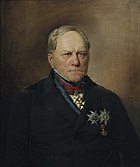

Public service & public thinking[]
- Jørgen von Ansbach (ca.1510–ca.1590) German-Norwegian timber merchant, Mayor of Skien
- Anne Clausdatter (1659-1713) a Norwegian businesswoman, owned Borgestad Manor
- Charlotte Schimmelmann (1757–1816) a Danish noble woman and salonist
- Diderik von Cappelen (1761–1828) a wholesaler, shipowner, estate owner and politician
- Ulrich Fredrich von Cappelen (1770–1820) ship owner and timber merchant
- Severin Løvenskiold (1777–1856), landowner, Prime Minister, Governor of Norway
- Peter Andreas Munch (1810–1863), historian, worked on the medieval history of Norway
- Otto Joachim Løvenskiold (1811–1882) politician and Supreme Court Justice
- Brynild Anundsen (1841–1913), Norwegian-American editor and publisher
- Hans H. Olson, (1847–1912) member of the Wisconsin State Assembly
- Gunnar Knudsen (1848–1928), Prime Minister of Norway 1908/1910 & 1913/1920
- Jon Hol (1851–1941) a politically active Norwegian engineer
- Hjalmar Johansen (1867–1913), polar explorer
- Halvdan Koht (1873–1965) a Norwegian historian and politician
- Carl Størmer (1874–1957) a Norwegian mathematician and astrophysicist
- Nils F. Ambursen (1876–1953) a Norwegian-American civil engineer and inventor
- George Awsumb (1880–1959), Norwegian-American architect
- Alfhild Hovdan (1904–1982) tourist manager, started the Trafalgar Square Christmas tree
- Herman Wold (1908–1992) a Swedish econometrician and statistician
- Einfrid Halvorsen (born 1937) a trade unionist and Mayor of Skien, 1983 to 1986
- Bjørn Tore Godal (born 1945) politician, Minister of Foreign Affairs 1994/1997
- Jon Fredrik Baksaas (born 1954), CEO of Telenor
- Margareth Øvrum (born 1958) an engineer and executive VP of Statoil
- Eskil Pedersen (born 1984) a Norwegian politician, in Utøya on 22 July 2011
- Bastian Vasquez (1990 – ca.mid 2015) a Norwegian ISIS jihadist
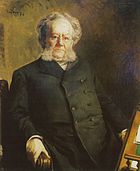

The Arts[]
- August Cappelen (1827–1852) a Norwegian painter of melancholic, dramatic landscapes
- Henrik Ibsen (1828–1906), a Norwegian playwright and theatre director
- Iver Holter (1850–1941) a Norwegian composer and conductor
- Rolf Christensen (1894–1962) actor in operettas, plays and farces and film director [12]
- Aage Samuelsen (1915–1987) a Norwegian evangelist, singer and composer
- Knut Wigert (1916–2006) a Norwegian actor, known for his Ibsen roles [13]
- Kari Lövaas (born 1939) a Norwegian operatic soprano
- Tor Åge Bringsværd (born 1939) an author, playwright, editor and translator
- Yngvar Numme (born 1944) singer, actor, revue writer and director [14]
- Torhild Staahlen (born 1947) a Norwegian operatic mezzo-soprano
- Iver Kleive (born 1949) a Norwegian composer and organist
- Audun Kleive (born 1961) a Norwegian jazz drummer
- Bugge Wesseltoft (born 1964) a jazz musician, pianist, composer and producer
- Gisle Kverndokk (born 1967) a Norwegian contemporary composer
- Heidi Hauge (born 1967) a Norwegian folk and country music singer
- Paal Flaata (born 1968) a Norwegian vocalist
- Bård Tufte Johansen (born 1969) a Norwegian comedian
- Wetle Holte (born 1973) a Norwegian jazz drummer and composer
- Lage Lund (born 1978) a Norwegian jazz guitarist
- Atle Pettersen (born 1989) a Norwegian singer and songwriter
- Julie Bergan (born 1994) a Norwegian singer and songwriter
Sport[]


- Per Mathias Jespersen (1888–1964) gymnast, team silver medallist at 1908 Summer Olympics
- Werner Nilsen (1904–1992) an American high-scoring soccer forward
- Nicolai Johansen (1917–1999) Secretary Gen. the Norwegian Football Association, 1955/1983
- Geir Karlsen (born 1948) retired footballer with nearly 300 club caps and 32 for Norway
- Dag Erik Pedersen (born 1959) a retired road racing cyclist, now anchorman with NRK
- Jeanette Nilsen (born 1972) handball player, team bronze medallist at the 2000 Summer Olympics
- Tommy Svindal Larsen (born 1973) retired footballer with 517 club caps and 24 for Norway
- Torjus Hansén (born 1973) a Norwegian former footballer with 373 club caps
- Frode Johnsen (born 1974) retired footballer with 518 club caps and 35 for Norway
- Alexander Aas (born 1978) a retired Norwegian footballer with 350 club caps
- Erik Midtgarden (born 1987) a Norwegian footballer with 320 club caps
Twin towns – sister cities[]
Skien is twinned with:
 Loimaa, Finland
Loimaa, Finland Minot, United States
Minot, United States Mosfellsbær, Iceland
Mosfellsbær, Iceland Onești, Romania
Onești, Romania Sorrento, Italy
Sorrento, Italy Thisted, Denmark
Thisted, Denmark Uddevalla, Sweden
Uddevalla, Sweden
References[]
- ^ "Forskrift om målvedtak i kommunar og fylkeskommunar" (in Norwegian). Lovdata.no.
- ^ Skien, snl.no
- ^ Haave, Jørgen (2017). Familien Ibsen. Museumsforlaget. ISBN 9788283050455.
- ^ Norske Kommunevåpen (1990). "Nye kommunevåbener i Norden". Retrieved 2009-01-18.
- ^ Ibsen, Henrik (21 September 1882), "Letter to Georg Brandes", Henrik Ibsens skrifter, University of Oslo
- ^ "Blom – slekt fra Skien". Store norske leksikon. Archived from the original on March 21, 2016. Retrieved February 1, 2016.
- ^ Wilhelm Swensen. "Kirken på Kapitelberget". Porsgrunn biblioteks. Retrieved September 1, 2016.
- ^ Jon Gunnar Arntzen. "Bratsberg". Store norske leksikon. Retrieved September 1, 2016.
- ^ NRK. "Synd at flyplassen blir lagt ned". nrk.no. Retrieved 3 April 2018.
- ^ "Himalaya Park". himalayapark.no. Retrieved 2009-02-06.
- ^ "Badeland, Skien fritidspark". visitgrenland.no. Retrieved 2009-02-06.
- ^ IMDb Database retrieved 24 December 2020
- ^ IMDb Database retrieved 24 December 2020
- ^ IMDb Database retrieved 22 December 2020
External links[]
| Wikimedia Commons has media related to Skien. |
| Look up Skien in Wiktionary, the free dictionary. |
- Municipal fact sheet from Statistics Norway
 Telemark travel guide from Wikivoyage
Telemark travel guide from Wikivoyage Skien travel guide from Wikivoyage
Skien travel guide from Wikivoyage- Municipal website (in Norwegian)
- Municipal website (in Norwegian)
- Municipal website (in English)
- Skien
- Municipalities of Vestfold og Telemark
- Cities and towns in Norway




